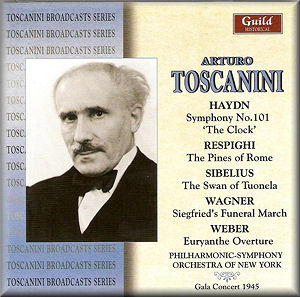 |
 |
|


alternatively
CD: AmazonUK
|
Toscanini Broadcast Series - Gala
Concert 1945
Joseph HAYDN (1732-1809)
Symphony No.101 in D major, The Clock (1793-94) [26:40]
Ottorino RESPIGHI (1879-1936)
Pini di Roma - symphonic poem (1924) [20:35]
Jean SIBELIUS (1865-1957)
Lemminkäinen Suite Op.22 - The Swan of Tuonela (1893 rev. 1897,
1900) [9:47]
Richard WAGNER (1813-1883)
Götterdämmerung, Act III: Siegfried’s Funeral Music (1876) [12:55]
Carl Maria von WEBER (1786-1826)
Euryanthe; overture J.291 (1823) [8:38]
 New York Philharmonic-Symphony Orchestra/Arturo Toscanini
New York Philharmonic-Symphony Orchestra/Arturo Toscanini
rec. 13 November 1945, Carnegie Hall, NYC, Benefit Pension Fund
concert
 GUILD GHCD 2368 [78:32]
GUILD GHCD 2368 [78:32] 
|
|
|
Though this question is often raised when discussing Toscanini’s
recordings, it’s worth a brief moment to consider it in the
context of this concert. It relates specifically to the superiority,
or otherwise, of Toscanini’s performances with the NBC vis-a-vis
the New York Philharmonic-Symphony orchestras. The consensus
is that the sonic disadvantage of Studio 8-H and the leaner
string tone of the NBC puts that body of recordings at a disadvantage
when set against, say, the Carnegie Hall and the NYPSO. It is
certainly pertinent to cite the pre-war recordings, live and
off-air, that preserved the conductor’s partnership with the
BBC Symphony in London, where a similar combination of a superior
location in Queen’s Hall and a superior body of tone from the
BBC strings, leads to a greater sense of rhythmic relaxation.
And this November 1945 Pension Fund benefit concert, live in
Carnegie Hall, reinforces the view that a congenial acoustic,
coupled with a responsively firm body of strings and eloquent
wind and brass principals, encouraged Toscanini toward a slightly
more affectionate address than with the NBC.
The Haydn symphony he performed was something of a talisman.
It was the first Haydn symphony he ever conducted, back in 1896,
at the very start of his career on the rostrum. It was in his
first NYPSO concert in 1929, the year in which he first recorded
it (he did it twice in the studio) and the only Haydn symphony
he took on tour with his orchestra. His approach remained very
consistent and the tempi vary very little over two decades.
We find in this concert performance a vital, imaginative and
highly attractive reading. Interestingly it’s not over-vibrated
by the strings, though they could have done had they wanted
– and the Presto, after the opening slow introduction, is articulated
very deftly. The flute lines come through well, attesting to
assured balancing between the winds and the strings – especially
true of the lower string line which is well articulated but
not too forceful. Altogether this is a well textured and highly
convincing performance, worthy of the conductor at his finest.
Again his Respighi Pines of Rome proves the superior
of the NBC version in 1953. There is greater colour, and texture
and also flexibility. Richer tone accounts for some of this,
but the glittering characterisation of the first, the Pines
of the Villa Borghese, attests to a more immediate rapport between
the conductor and his old orchestra. The clarinet principal
shines in the third panel whilst the finale is a blazing affair,
inciting frenzied applause. But there is also atmosphere in
this concert, and that comes via Sibelius, whose Swan of
Tuonela receives a sensitively phrased and perceptive reading,
surely the best of Toscanini’s performances of it. There are
numerous examples of his Wagner chunks, and this commanding
Götterdämmerung is about as good as it gets. To end with
Weber’s overture to Euryanthe is to send people home
in high spirits – a brightly and engaging animated reading.
The musical virtues of this disc are manifold, and even those
jaded by the Toscanini Question will find much to enjoy here.
Jonathan Woolf
|
|

